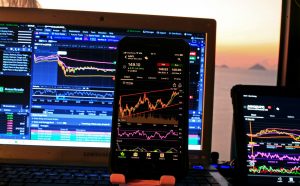
Like any other form of digital trading, the forex is not an easy market. However, when done right, there is a potential to make profitable returns from your trade. One way to ensure you make the right trade decisions is to use the best forex indicators in your strategy.
Forex trading indicators work under the assumption that the market is not random. The same is said in some economic theories. According to experts, the forex market has a pattern of behavior in different conditions.
It is assumed that this behavior is repetitive, with certain patterns often recurring on the charts.
There are tens of forex trading indicators available. However, only a few are regarded as the more important ones to master, whether you are a beginner or professional forex trader. Moving Averages are some of them.
Moving averages are forex indicators used to help traders know when to expect certain patterns to exploit them when they occur.
In this article, you will learn about MA technical indicators in forex trading and how to use them for your trade.
SMA (Simple Moving Average)
A simple moving average or SMA can be defined as a value of the mean average closing price calculated over a given period. This is implied by the word ‘moving’, where experts calculate the new value whenever a given period advances. This reflects the changes in the price of a pair.
For instance, the 20-day moving average referred to the mean average of a pair’s closing price over the last 20 days.
The purpose of the Simple Moving Average indicator
SMA is used to detect price movements to be able to identify a trend. As a lagging indicator, SMA uses past prices to provide signals whenever a trend begins. The longer the SMA period, the greater the indication and a slower reaction to market changed. Because of this, SMA is not the most ideal forex indicator if you want to receive an advance warning before a market movement.
SMAs are the best indicators for traders interested in confirming trends for future trades. For more accurate trends, traders can operate multiple SMAs on the same chart. One can be for shorter time periods while another for longer periods. Typical values for longer SMAs are 50, 100, and 200, while shorter SMAs have values of 10, 25, or 20.
SMA in trend signaling
A simple moving average will signal the start of a new trend when there is a short-term average cross-over to a long-term average. When a short-term average movies above the long-term average, this is usually the sign of an uptrend. When the long-term average moves over a short-term average, this signals the start of a downtrend.
To get an idea of the best averages for you, you can experiment with different period lengths.
Exponential Moving Average
EMA or Exponential Moving Average is an indicator used to work out the average price of a pair over a defined period. EMA gives a higher weighting to recent price value. The name exponential is given because the weighting amount decrease for every successive old price value is exponential. This means that EMA as an indicator responds faster to price changes compared to SMA.
Using a moving average strategy
To successfully use SMA and EMA indicators in your strategy, you need to trade every time there is a cross in your moving averages.
Buy whenever the shorter average crosses the longer one and sell when the longer average crosses the shorter average. This trading system ensures that you always have a trading position, be it long or short, for every currency pair you trade.
You can exit a trade whenever the shorter MA exceeds the longer one and place a new trade in the opposite of the trade you just exited. This way, you will be effectively reversing and squaring, thus maximizing your trading potential.
If you do not plan to be actively trading all the time, the best option would be using a triple moving average. This includes a third moving average for the longest period to act as a filter for trends.
In this trade, you do not have to place a trade when the shorter trade crosses the middle one. You can only place long trades when the shirt and medium MAs move above the longest MA and go short when the short and medium ones fall below the longest MA.








Directly in the purpose
thetittyfuck
Appreciating the hard work you put into your blog and detailed information you provide.
It’s awesome to come across a blog every once in a while that
isn’t the same out of date rehashed material. Excellent read!
I’ve bookmarked your site and I’m including your RSS feeds to my Google account.
You’re so interesting! I don’t believe I’ve truly read through a single thing like this
before. So wonderful to discover another person with some original
thoughts on this issue. Really.. thank you for starting this up.
This website is one thing that’s needed on the web, someone with a
little originality!
Thanks for your blog, nice to read. Do not stop.
thanks for sharing helpful information about the average indicators traders.
We found some fresh ideas in your post. The author have presented it nicely. Thank you for educating us.